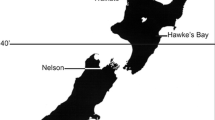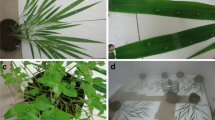Abstract
In 1962 in the Netherlands a foot rot due toNectria haematococca Berk. & Br. var.cucurbitae (Snyd. & Hans.) Dingley occurred inCucurbita ficifolia, the rootstock of grafted cucumber grown in glasshouses. The Dutch isolates of the pathogen proved to be identical with ones isolated from abroad.C. ficifolia seedlings grown in infested soil showed a foot rot at the base of the hypocotyl when about two weeks, old, after, which the plants soon died off completely. Though the fungus could grow from the rootstock into the cucumber graft, it never showed systemic growth in still living stems. If soil-infestation was only slight,C. ficifolia plants became attacked at a later stage of development. This was in agreement with the dying off of mature cucumbers in the glasshouses at the commencement of cropping. All Cucurbitaceae which were grown in infested soil finally succumbed to the disease. No resistant substitute for theC. ficifolia rootstock was found. Other crops appeared to be resistant. The seed-borne character of the pathogen was demonstrated by injecting fruits with a spore suspension at different developmental stages. When the surviving fruits were harvested, only those inoculated when three to five weeks old contained viable seeds, some of which were infected superficially as well as internally The use of seeds from bruised and infected fruits might have introduced the pathogen into the greenhouses of holdings specializing in selling grafted plants and cucumber seedlings, thousands of which are daily sent all over the country, thus spreading the disease. In recent years this has been avoided by using only seeds from nondamaged fruits and by regularly steaming the soil in which the seedlings are grown.
Samenvatting
In 1962 en 1963 kwam in Nederland een voetziekte voor bij kaskomkommers, geënt opCucurbita ficifolia-onderstam. De ziekte werd veroorzaakt doorNectria haematococca Berk. & Br. var.cucurbitae (Snyd. & Hans.), Dingley (syn. metHypomyces solani Rke & Berth. emend. Snyd. & Hans. var.cucurbitae Snyd. & Hans.,Fusarium javanicum Koord. var.ensiforme (Wr. & Reinking) Wr. enFusarium solani f.cucurbitae Snyd. & Hans.). De schimmel bleek identiek te zijn met isolaties uit Cucurbitaceae, afkomstig uit andere landen (fig. 1). Zaailingen vanC. ficifolia, opgekweekt in besmette grond, vertoonden ongeveer twee weken na het zaaien een aantasting aan de voet van het hypocotyl, waarna de planten snel volledig afstierven (fig. 2). Ofschoon de schimmel via de entplaats in de komkommer-bovenstam kon doordringen, werd de levende stengel nooit systemisch doorgroeid. Als de grond slechts licht geïnfecteerd werd, bleken planten vanC. ficifolia nog of latere leeftijd aangetast te kunnen worden (tabel 1) Dit is in overeenstemming met het verschijnsel, van het afsterven van komkommers in kassen als de planten juist vrucht gaan dragen.
Alle Cucurbitaceae die in besmette grond werden opgekweekt, stierven af. Er werd geen vervanger voor deC. ficifolia-onderstam gevonden die resistent was tegen dezeFusarium. Andere planten die in de kassen gekweekt worden zoals freesia's, bleken resistent te zijn.
De schimmel bleek met zaad te kunnen overgaan, hetgeen o.a. aangetoond werd door een groot aantal vruchten van verschillende leeftijd te injiceren met een sporensuspensie (tabel 2). Alleen die welke drie tot vijf weken na de bloei geïnjiceerd waren, bevatten later kiemkrachtige zowel uitwendig als inwendig met de schimmel besmette zaden op die plaatsen waar het vruchtvlees weinig of niet was aangetast (fig. 3 en 4). Het is mogelijk, dat de scimmel door het gebruik van zaad uit gekneusde en besmette vruchten binnengekomen is in de kassen van gespecialiseerde entbedrijven, vanwaaruit dagelijks duizenden enten en zaailingen door het gehele land worden verzonden. Op deze wijze kan de snelle verspreiding van het pathogeen verklaard worden. In latere jaren kon de ziekte vermeden worden door slechts zaden uit gave vruchten voor het opkweken vanC. ficifolia-onderstammen te gebruiken en de grond in de, tabletten geregeld te ontsmetten.
Similar content being viewed by others
References
Aa, H. A. van der &W. F. Prud'homme van Reine,-1964. Aantasting van Cucurbita ficifolia door Fusarium javanicum var. ensiforme. Neth. J. Pl. Path. 70: 69–70.
Bravenboer, L.,-1964. De invloed van intensivering en specialisatie van de komkommerteelt op aantasting door Fusarium javanicum var. ensiforme. Neth. J. Plant Path. 70: 69.
Bravenboer, L. enD. Theune,-1964. Fusarium javanicum in komkommers. Jversl. Proefstn Groente- en Fruitteelt Glas Naaldwijk, 1963: 151–153.
Conroy, R. J.,-1953a. Fusarium foot rot of Cucurbits. Contr. N.S.W. Dep. Agr. biol. Brch Div. sci. Serv. 370: 1–4.
Conroy, R. J.,-1953b, Fusarium foot rot of Cucurbits in New South Wales. J. Aust. Inst. agric. Sci. 19: 106–108.
Conroy, R. J.,-1955. Fusarium foot rot of Cucurbits. Agr Gaz. N.S.W. 64: 655–658.
Conroy, R. J.,-1959. Fusarium wilts and foot rot of Cucurbits. Contr. N.S.W. Dep. Agric. biol. Brch Div. sci. Serv. 412: 1–2.
Conroy, R. J.,-1961. A field occurrence of Fusarium solani (Mart.) App. et Wr. forma cucurbitae Snyd. et Hans. on Cucumis sativus L. Aust. J. Sci. 23: 412.
Dingley, J. M.,-1961. New records of fungous diseases in New Zealand, 1960–1. N.Z.J. agric. Res. 4: 336–347.
Doidge, E. M.,-1938. Some South African Fusaria. Bothalia 3: 331–483.
Doidge, E. M. &L. J. Kresfelder,-1932. A wilt disease of cucurbits. Fmg S. Agr. 7: 299–300.
Gries, G. A.,-1946. Physiology of Fusarium foot rot of squash. Bull. Conn. agric Exp. Stn. 500: 1–20.
Jaarverslag proefstation voor de groenten- en fruitteelt onder glas te naaldwijk,-1959. Jversl. Proefstn Groente- en Fruitteelt Glas Naaldwijk 1958.
Jaarverslag proeftuin “zuid-hollandsch glasdistrict” te naaldwijk,-1944, 1945. Jversl. Proeftuin zuid-holl. Glasdistr. Naaldwijk 1943, 1944.
Maan, W. J.,-1946. Het enten van komkommers. Tuinbouw 1: 9–15.
Prasad, N.,-1949. Variability of the cucurbit foot-rot fungus, Fusarium (Hypomyces) solani f. cucurbitae. Phytopathology 39: 133–141.
Rietberg, H.,-1940. De fusariose van komkommers en meloenen. Meded. TuinbVoorlDienst 20: 1–48.
Schippers, B.,-1966. Compatibiliteit, geslacht en verspreiding van Fusarium (Hypomyces) solani f. cucurbitae (F. javanicum var. ensiforme), veroorzaker van voetrot by Cucurbitaceae. Neth. J. Pl. Path. 72: 207.
Schippers, B. &W. C. Snyder,-1967. Mating type and sex of Fusarium solani f. cucurbitae race 1 in the Netherlands. Phytopathology. In press.
Snyder, W. C.,-1938. A Fusarium foot rot of Cucurbita. Phytopathology 28: 19.
Snyder, W. C.,-1940. White perithecia and the taxonomy of Hypomyces ipomoeae. Mycologia 32: 646–648.
Toussoun, T. A. &W. C. Snyder,-1961. The pathogenicity, distribution and control of two races of Fusarium (Hypomyces) solani f. cucurbitae. Phytopathology 51: 17–22.
Wollenweber, H. W. &O. A. Reinking,-1935. Die Fusarien, ihre Beschreibung, Schadwirkung und Bekämpfung. Paul Parey. Berlin.
Author information
Authors and Affiliations
Additional information
In cooperation withH. A. van der Aa, P. Ketner andW. F. Prud'homme van Reine.
Rights and permissions
About this article
Cite this article
Kerling, L.C.P., Bravenboer, L. Foot rot ofCucurbita ficifolia, the rootstock of cucumber, caused byNectria haematococca var.Cucurbitae . Netherlands Journal of Plant Pathology 73, 15–24 (1967). https://doi.org/10.1007/BF02023674
Accepted:
Issue Date:
DOI: https://doi.org/10.1007/BF02023674




